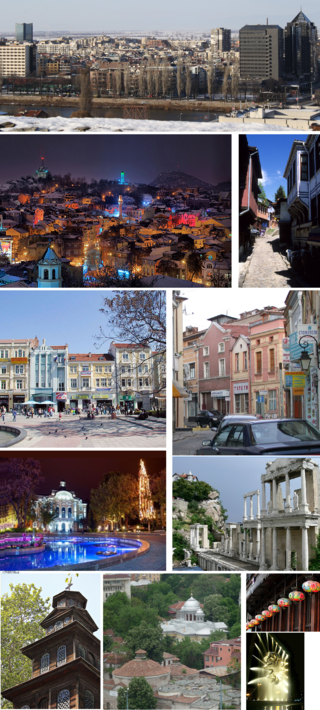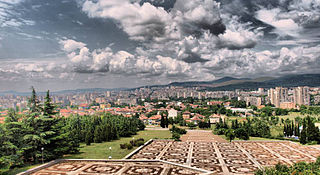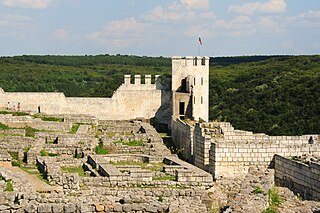
Plovdiv (Bulgarian: Пловдив, pronounced[ˈpɫɔvdif] is the second-largest city in Bulgaria, 93 miles southeast of the capital Sofia. It had a population of 371,536 as of 2024 and 675,000 in the greater metropolitan area. Plovdiv is a cultural hub in Bulgaria and was the European Capital of Culture in 1999 and 2019. The city is an important economic, transport, cultural, and educational centre. Plovdiv joined the UNESCO Global Network of Learning Cities in 2016.

Pazardzhik Province is a province in Southern Bulgaria, named after its administrative and industrial centre: the city of Pazardzhik. The territory is 4,456.9 km2 (1,720.8 sq mi) that is divided into 12 municipalities with a total population of 275,548 inhabitants, as of February 2011.

Svilengrad is a town in Haskovo Province, south-central Bulgaria, situated at the tripoint of Bulgaria, Turkey, and Greece. It is the administrative centre of the homonymous Svilengrad Municipality.

Stara Zagora is a city in Bulgaria, and the administrative capital of Stara Zagora Province. It is located in the Upper Thracian Plain, near the cities of Kazanlak, Plovdiv, and Sliven. Its population is 121,582 making it the sixth largest city of Bulgaria, located North East of Plovdiv.
Seuthopolis was an ancient hellenistic-type city founded by the Thracian king Seuthes III between 325–315 BC which was the capital of the Odrysian kingdom.

Troesmis was an ancient Dacian town and later ancient Roman city and legionary fortress, a major site situated on the Danube and forming a key part of the Limes Moesiae frontier system. Around the fortress the Geto-Dacian town developed.

Parvomay is a town located in the Plovdiv Province of southern Bulgaria, part of the similarly named municipality. It is geographically close to the towns of Sadovo and Chirpan. The name literally means First of May, i.e., May Day, in English and is sometimes transliterated as Parvomai or Purvomai.

Aigosthena was an ancient Greek fortified port city of Megaris, 19 km (12 mi) northwest of the ancient city of Megara to which it belonged. It is also the name of the coastal settlement at the foot of the ancient city walls, also known as Porto Germeno. The ancient citadel which stands at the foot of Mt Cithaeron and extends down to the sea at the inlet of Aigosthena, on the east side of the Gulf of Corinth, is famous for retaining several of the tallest surviving towers of ancient Greece.

Vize is a town in Kırklareli Province in the Marmara region of Turkey. It is the seat of Vize District. Its population is 15,116 (2022). The mayor is Ercan Özalp (CHP). The town's distance to the provincial centre is 56 km (35 mi). Vize is situated on state road D.020, which runs from Istanbul to Edirne via Kırklareli. In 2012 Vize was designated a Cittaslow.

Shabla is a town and seaside resort in northeastern Bulgaria, administrative centre of the Shabla Municipality part of Dobrich Province. Shabla municipality includes the following villages: Bojanovo, Chernomortsi, Durankulak, Ezerets, Gorichane, Gorun, Granichar, Krapets, Prolez, Smin, Staevtsi, Tvarditsa, Tyulenovo, Vaklino, and Zahari Stoyanovo. As of December 2009, the town itself had a population of 3,586 inhabitants. It is situated on the Bulgarian Black Sea Coast in the vicinity of the salt-water Lake Shabla and Bulgaria's easternmost point, Cape Shabla.

Sucidava was a Dacian and Daco-Roman city situated in Corabia, Romania, on the north bank of the Danube. It developed from the 270s AD and especially after the construction of Constantine's Bridge the northern side of which it protected.
Dragoynovo is a village in central southern Bulgaria, in the Parvomay municipality of Plovdiv Province.
Zaldapa was a large Late Roman fortified city in Scythia Minor/Moesia, located near today's Abrit, Bulgaria.

Philippopolis is one of the names of the ancient city situated where Plovdiv is today. The city became one of the largest and most important in the region and was called "the largest and most beautiful of all cities" by Lucian. During most of its recorded history, the city was known by the name Philippopolis after Philip II of Macedon. Philippopolis became part of the Roman empire and capital of the Roman province of Thracia. According to Ammianus Marcellinus, Philippopolis had a population of 100,000 in the Roman period.

Rahovets was an ancient Thracian, medieval and Ottoman fortress in Northeastern Bulgaria. It is located on a hill close to the town of Gorna Oryahovitsa (2 km) and Veliko Tarnovo (5 km).

The Shumen Fortress is an archaeological site overlooking the city of Shumen in north-eastern Bulgaria.

Hisar Kapia is a medieval gate in Plovdiv's old town and one of the most famous tourist sights in the city. The gate was built in the 11th century AD over the foundations of a gate from Roman times. Hisar Kapia is one of the three entrances to the acropolis of ancient Plovdiv. During the rule of the Ottoman empire revival houses were embedded in the remains of the old stone walls around the gate.

The old town in Plovdiv is an architectural and historical reserve located on three of Plovdiv's hills: Nebet Tepe, Dzhambaz Tepe and Taksim Tepe.
Vishegrad is a medieval fortress in the Rhodope Mountains of southern Bulgaria rising over a promontory in the valley of the river Arda. About one kilometer south on another hill lie the ruins of an ancient Thracian fort. Its name means High Town.































